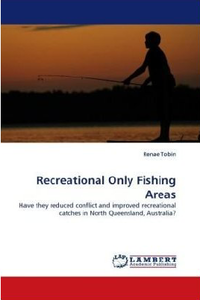Recreational Only Fishing Areas: have they reduced conflict and improved recreational catches in North Queensland, Australia?
Tobin, Renae (2010) Recreational Only Fishing Areas: have they reduced conflict and improved recreational catches in North Queensland, Australia? Lambert Academic Publishing, Saarbrücken, Germany.
![[img]](https://researchonline.jcu.edu.au/11380/2.hassmallThumbnailVersion/11380_Tobin_2010_Book_Cover.bmp)
|
Image (BMP) (Book Cover)
- Cover Image
Download (323kB) |
|
|
PDF (Front Pages)
- Supplemental Material
Download (451kB) |
Abstract
Competition and conflict between commercial and recreational fishers over shared fish stocks is a historic and current reality, and has been documented in all developed and some developing countries (Ruello and Henry 1977; Gartside 1986; Aas and Skurdal 1996; Sumaila 1999; Kearney 2002a, b; Pitcher and Hollingworth 2002; Sumaila 2002; McPhee and Hundloe 2004; Arlinghaus 2005). Although recreational and commercial fishing sectors are often in competition to the point of conflict with other users (including within their own sector), apparent conflict between recreational and commercial fishers is currently one of the most significant issues for fisheries management in Australia and many other countries (West and Gordon 1994; Brayford 1995; van Buerren et al. 1997; McPhee and Hundloe 2004; Arlinghaus 2005). Conflicts may be severe and expensive of management resources, regardless of whether they are “real” or only perceived (i.e. based on fishers’ beliefs but not substantiated) by one or more of the involved fishing sectors (Jacob and Schreyer 1980; Aas and Skurdal 1996).
Many authors suggest conflict between recreational and commercial fishing sectors is increasing as contact between the sectors increases, particularly in coastal areas and close to population centres (Gartside 1986; Edwards 1991; Hannah and Smith 1993; Brayford 1995; Ramsay 1995; Scialabba 1998; O'Neill 2000; McPhee et al. 2002; Steffe et al. 2005b). Increasing contact between the sectors may be due to a number of factors including: increased population; increased recreational fishing participation; and improved accessibility to previously remote fishing areas (Smith 1980; Henry 1984; Edwards 1990; van der Elst 1992; Hannah and Smith 1993; Green 1994; West and Gordon 1994; Kearney 2001, 2002b; Williams 2002a; Sumner 2003; Steffe et al. 2005b). Although conflict can occur when commercial and recreational fishers target different species, the conflict situation is enhanced when the same species are targeted by both sectors (Arlinghaus 2005).
In an attempt to reduce contact between competing sectors and hence reduce conflict, sector-specific closures are introduced in previously shared areas (Samples 1989; Department of Primary Industries and Fisheries 2003). Recreational Only Fishing Areas (ROFAs) (i.e. areas where commercial fishing is banned, leaving exclusive access to recreational fishers (anglers)) are becoming increasingly common in Australia and other developed countries (Owen 1981; Rogers and Gould 1995; Kearney 2002b; McPhee et al. 2002; Walters 2003). All States and Territories in Australia have implemented ROFAs, particularly in coastal areas. For instance, in New South Wales (NSW) in May 2002, 30 areas along the coast became “Recreational Fishing Havens” (termed ROFAs here), where commercial fishing was either completely banned or significantly restricted. These ROFAs resulted in the closure of 24% of the State’s estuarine waters to commercial fishing (NSW Department of Primary Industries 2004; Steffe et al. 2005b). In the Northern Territory, the rise of the recreational fishing sector in the 1980s shifted the focus of barramundi management to the allocation of the resource between the competing sectors. This resulted in the exclusion of commercial fishing from some areas including all freshwater areas, plus Darwin Harbour, Kakadu National Park, and the Daly, Mary and Roper Rivers (Pender 1995; Griffin 2003). In Victoria, only 4 of 25 bays and inlets allow commercial finfish fishing, making the remaining areas effectively ROFAs for finfish (Murray MacDonald, Department of Primary Industries Victoria, pers. comm., 2006)
| Item ID: | 11380 |
|---|---|
| Item Type: | Book (Scholarly Work) |
| ISBN: | 978-3-8383-2911-6 |
| Keywords: | recreational only fishing areas, fisheries, management, conflict, attitudes, perceptions, barramundi |
| Related URLs: | |
| Additional Information: | This publication does not have an abstract. The first three paragraphs of the Introduction are displayed as the abstract. |
| Funders: | CRC Reef Research Centre Ltd., James Cook University |
| Projects and Grants: | PhD Project Renae Tobin |
| Date Deposited: | 13 Aug 2010 01:14 |
| FoR Codes: | 07 AGRICULTURAL AND VETERINARY SCIENCES > 0704 Fisheries Sciences > 070403 Fisheries Management @ 100% |
| SEO Codes: | 83 ANIMAL PRODUCTION AND ANIMAL PRIMARY PRODUCTS > 8302 Fisheries - Wild Caught > 830201 Fisheries Recreational @ 50% 83 ANIMAL PRODUCTION AND ANIMAL PRIMARY PRODUCTS > 8302 Fisheries - Wild Caught > 830204 Wild Caught Fin Fish (excl. Tuna) @ 50% |
| Downloads: |
Total: 671 Last 12 Months: 11 |
| More Statistics |



